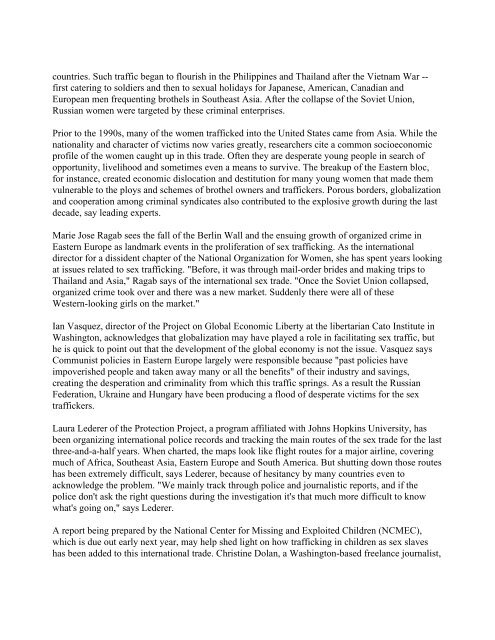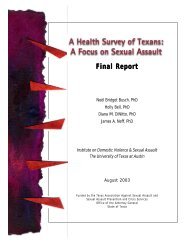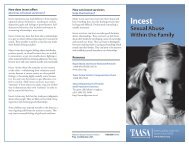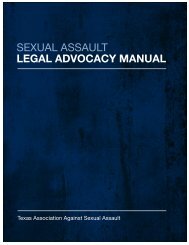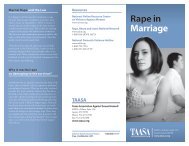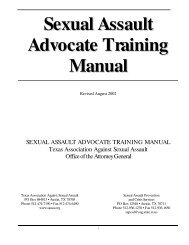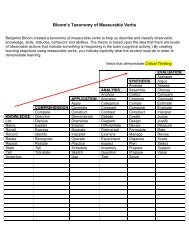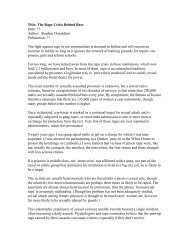Sex Slave Trade Enters the US
Sex Slave Trade Enters the US
Sex Slave Trade Enters the US
You also want an ePaper? Increase the reach of your titles
YUMPU automatically turns print PDFs into web optimized ePapers that Google loves.
countries. Such traffic began to flourish in <strong>the</strong> Philippines and Thailand after <strong>the</strong> Vietnam War --<br />
first catering to soldiers and <strong>the</strong>n to sexual holidays for Japanese, American, Canadian and<br />
European men frequenting bro<strong>the</strong>ls in Sou<strong>the</strong>ast Asia. After <strong>the</strong> collapse of <strong>the</strong> Soviet Union,<br />
Russian women were targeted by <strong>the</strong>se criminal enterprises.<br />
Prior to <strong>the</strong> 1990s, many of <strong>the</strong> women trafficked into <strong>the</strong> United States came from Asia. While <strong>the</strong><br />
nationality and character of victims now varies greatly, researchers cite a common socioeconomic<br />
profile of <strong>the</strong> women caught up in this trade. Often <strong>the</strong>y are desperate young people in search of<br />
opportunity, livelihood and sometimes even a means to survive. The breakup of <strong>the</strong> Eastern bloc,<br />
for instance, created economic dislocation and destitution for many young women that made <strong>the</strong>m<br />
vulnerable to <strong>the</strong> ploys and schemes of bro<strong>the</strong>l owners and traffickers. Porous borders, globalization<br />
and cooperation among criminal syndicates also contributed to <strong>the</strong> explosive growth during <strong>the</strong> last<br />
decade, say leading experts.<br />
Marie Jose Ragab sees <strong>the</strong> fall of <strong>the</strong> Berlin Wall and <strong>the</strong> ensuing growth of organized crime in<br />
Eastern Europe as landmark events in <strong>the</strong> proliferation of sex trafficking. As <strong>the</strong> international<br />
director for a dissident chapter of <strong>the</strong> National Organization for Women, she has spent years looking<br />
at issues related to sex trafficking. "Before, it was through mail-order brides and making trips to<br />
Thailand and Asia," Ragab says of <strong>the</strong> international sex trade. "Once <strong>the</strong> Soviet Union collapsed,<br />
organized crime took over and <strong>the</strong>re was a new market. Suddenly <strong>the</strong>re were all of <strong>the</strong>se<br />
Western-looking girls on <strong>the</strong> market."<br />
Ian Vasquez, director of <strong>the</strong> Project on Global Economic Liberty at <strong>the</strong> libertarian Cato Institute in<br />
Washington, acknowledges that globalization may have played a role in facilitating sex traffic, but<br />
he is quick to point out that <strong>the</strong> development of <strong>the</strong> global economy is not <strong>the</strong> issue. Vasquez says<br />
Communist policies in Eastern Europe largely were responsible because "past policies have<br />
impoverished people and taken away many or all <strong>the</strong> benefits" of <strong>the</strong>ir industry and savings,<br />
creating <strong>the</strong> desperation and criminality from which this traffic springs. As a result <strong>the</strong> Russian<br />
Federation, Ukraine and Hungary have been producing a flood of desperate victims for <strong>the</strong> sex<br />
traffickers.<br />
Laura Lederer of <strong>the</strong> Protection Project, a program affiliated with Johns Hopkins University, has<br />
been organizing international police records and tracking <strong>the</strong> main routes of <strong>the</strong> sex trade for <strong>the</strong> last<br />
three-and-a-half years. When charted, <strong>the</strong> maps look like flight routes for a major airline, covering<br />
much of Africa, Sou<strong>the</strong>ast Asia, Eastern Europe and South America. But shutting down those routes<br />
has been extremely difficult, says Lederer, because of hesitancy by many countries even to<br />
acknowledge <strong>the</strong> problem. "We mainly track through police and journalistic reports, and if <strong>the</strong><br />
police don't ask <strong>the</strong> right questions during <strong>the</strong> investigation it's that much more difficult to know<br />
what's going on," says Lederer.<br />
A report being prepared by <strong>the</strong> National Center for Missing and Exploited Children (NCMEC),<br />
which is due out early next year, may help shed light on how trafficking in children as sex slaves<br />
has been added to this international trade. Christine Dolan, a Washington-based freelance journalist,


